Hammocks in Yucatan
Editor's Note: What do you say about something that so much has been said about? And about which so much can be said? Before we came to the Yucatan, we thought the best hammocks had sticks at each end to keep them straight. We had heard the word "hammock" of course, but had barely seen one and certainly did not know how to SLEEP in one. Learning about and buying our first hammock was a rite of passage for us when we moved to Merida, and we had to sleep in those hammocks for three months while we waited for our furniture to arrive. Over the years we grew quite fond of our hammocks, we learned what we liked in a hammock and we learned how to use them in our life to make our life better.
Keith Raymond, a local expat who has a business selling hammocks, has generously written this article to tell us some things we may not know about hammocks, how to choose one and what to look for. After his article, we added some of our own insights and hard-won tips and tricks. We hope you enjoy and learn something from this article... and if you have more to add, please do!
Buying A Hammock in Yucatan
If you are thinking of moving or have finally made the move to the Yucatan area, you may be considering what you need to set up your new home. Your tastes may include decorating it with the local styles to immerse yourself into the local way of life. In your home in Yucatan, nothing is more quintessential than a hammock. For an expatriate, buying a hammock solidifies your new lifestyle in Mexico.
The Yucatan is known for its hammocks, but not all hammocks are alike. Care has to be taken to make sure you are getting an authentic, quality hammock. The options can seem confusing, as there are many types and sizes of hammocks available. Add in the many people and places to buy from, and the truth is, you may not always be getting the best quality hammock. If you want the right hammock for you that will work and will last, it is important to know what to look for and how to evaluate a potential hammock.
Types of Hammocks
One way to categorize hammocks is between "thick cord" and "thin cord" hammocks. With a thick cord hammock, the mesh looks and feels like a basketball net. The cords are slightly less thick than a clothesline. A thin cord hammock looks and feels more like a fish net, and is created with a much finer cord.
Both cord styles are comfortable. A thick cord hammock can stand up under more heavy usage. If you intend to take your hammock along on trips and outings, it can take the punishment. The thin cord is better if you plan to leave your hammock in the same place for regular, everyday use. Hammocks come in either cotton or nylon typically. Cotton hammocks provide a more comfortable thread against the body, whereas the nylon is a stronger fiber and will not fade in the sun.
Hammock Sizes
Another thing to consider is the size of the hammock. Sizes can be confusing, so when you buy a hammock, be sure to not only ask, but stretch the hammock out to be sure. The single size, with a width of about 3 feet, is good for solo use and day trips. The next size up is called "matrimonial". This is considered a queen-size hammock, and has a bed width of about 5.5 feet. The matrimonial hammock is considered ideal for couples. If you want a hammock with more space, a king-size hammock is about 6.5 feet wide is great for 2 or more. The Jumbo size, at over 9 feet wide is the largest hammock, and can hold the whole family or a group of friends.
If you are looking for something more conventional, there are also those hammocks that come with a spreader bar at the head and foot of the hammock bed. This creates the hammock bed as a rectangular formation much like a mattress. The bar is called a spreader-bar and these are considered American hammocks. These hammocks are often the type that hotels and resorts get because of the heavier cord and flatter, bed-like appearance. They are ideal for people who are not quite comfortable with the more "traditional" Mexican hammock.
The best Mexican hammocks are handmade by the indigenous Mayans here in the Yucatan. These are authentic hammocks, hand-woven on simple rectangular looms by Mayan women in many of the small Mayan villages dotting the Yucatan Peninsula. You'll recognize a genuine hammock by its quality and craftsmanship.
How To Spot A Good Hammock
To spot a genuine Mayan-made hammock, check the weave. A Mayan hammock weave is uniform throughout the hammock bed, and the color transition is even. The best hammocks have a tight weave, with the gaps between the threads uniformly narrow and firm. When choosing a hammock, be sure to inspect the cords for frays or flaws. Check where the cords are knotted, as good quality Mayan made hammocks will have knots at the ends of the bed rather than in the middle of the bed. The best way to check a hammock is to have two people each hold on to one end and stretch it out as you would if you were going to hang it.
A well-made hammock with a tight weave will provide excellent support, provide hours of relaxation and last for years.
Working Gringos Hammock Tips
We aren't hammock experts, but after ten years we know a thing or two about hammocks in the Yucatan.
For one thing, the best hammocks in Merida are not usually purchased from men roaming the Plaza Grande or hanging out in front of tourist hotels. Probably not on the beach in Progreso either. There are some great stores in Merida where Yucatecans buy their hammocks, and many of them are down near the main mercado, south of the Plaza Grande. We bought our first hammock (and many subsequent ones...) from the store called Aguacate on Calle 58. Another great place to buy well-constructed hammocks is at a prison... inmates make great hammocks! We also have heard that the nearby city of Tixcocob is a great place to buy a great hammock.
Hammocks can be made from any type of string, but the most common ones in Merida are either made of nylon string, which withstands weather well and is good for an outdoor hammock, or cotton string, which we prefer but really should be kept indoors and out of the sun and rain. Frankly, all hammocks should be kept out of the sun and rain to keep them strong. Nylon string hammocks come in brighter colors and because hammocks breathe anyway, nylon string hammocks are perfectly acceptable, even to those of us who wouldn't be caught dead wearing polyester clothing. Cotton string hammocks feel lovely, but the colors are usually more muted. You can also find hammocks made of henequen (strong, but not very comfortable). At the last Día de los Muertos celebration in the Plaza Grande, we saw a "winter" hammock that was made of string created from rags... it looked beautiful in a vintage sort of way, and was probably much warmer during those cold norte nights.
Lying in a Yucatecan hammock is an art, and if it is done correctly, probably more comfortable than lying in bed. We were taught to stand sideways, facing away from the hammock with it hanging behind us. Then take the side of the hammock farthest from us, and hang it over our shoulders. Take the side closest, pull it out beneath us and sit down. Now pivot about 45 degrees to one side or the other and lie down, lying at a diagonal in the hammock.
Getting into the hammock this way ensures that you are getting in safely. It also allows you lie flatter than if you put your head in one end and your feet in the other. We have found that a small pillow under our heads is often a nice addition to sleeping in a hammock. Sleeping in a hammock is much cooler than sleeping in a bed, and sometime during the winter can make you cold enough to want a blanket under you! Got mosquitos? You can buy a special hammock-shaped mosquito net at the same store where you buy your hammock. Just ask for a mosquitera.
One of the best things about sleeping in a hammock is that you can rock yourself to sleep. Hammocks are great for rocking babies to sleep, and many Yucatecan babies are raised sleeping in hammocks, with the hammock sides folded up over them so they can't roll out, but they can still breathe. It's pretty brilliant, really.
It is rare to find a building in the Yucatan without a few hammock hooks. Hammock hooks used to be big iron rings embedded in long, round blocks of wood that were then embedded into mamposteria (stone and mortar) walls. You can still find those in antique stores around town and re-use them... they lend an air of authenticity and history to a renovated home. Or you can buy one of the many new styles of hammock hooks. Most of those can be found downtown at the mercado, or in a local hardware store. It's easy to install a hamaquero (hammock hook)... you just dig a hole in your cement block wall, install the hook, surround it with more cement and paint. Of course, tree trunks make good places to hang hammocks, as do pillars and upright columns. We once despaired because we had stone columns and wanted to hang a hammock from them... but you can't embed a hamaquero in a stone column. Not to worry... there's a solution for that too. Our workmen installed wrought iron rings around the column that were welded into place, and the hammocks were hung from them.
To attach your hammock to your hamaquero, you need two things: the special length and configuration of rope, called sogas para hamaca (ropes for a hammock) and the hooks which attach the rope loops to the hammock hooks and are called ganchos para hamacas or eses (for the "S" shape that they come in). The sogas are usually sold in pairs, because you need one for each side, and come in colors to match (or not!) your hammock. All of these things can be found in the mercado, and often times even in a corner store in your neighborhood.
Hammocks do get dirty, and they should be washed periodically. We bought those nets that are supposedly great for washing hammocks in a washing machine, but we didn't find them to work well at all. Our favorite way of washing a hammock is in a bucket with soap and water. Rinse it a few times, and then hang it out in the sun. It will dry even better if you spread it apart with a stick in the middle. If you can't find a stick, a broom handle will suffice.
Hammocks also fall apart. And when you have a favorite hammock, that's a bit of a disaster. So it is good to know that there are people in Merida who repair hammocks. In fact, if you are lucky, someone who repairs hammocks will come to your door. We were lucky once, and the man set up shop in our garage. He asked for a chair, took off his shoes and got to work. It took about an hour to restring our hammock, which we had thought was irreparable.
Probably the most esoteric thing we ever learned about hammocks was how to fold one up to hang it so it stays on the hammock hook and looks good without getting tangled. But THAT secret is one that has to be taught in person and practiced... it is too complicated to explain in words, even for us! Chances are the lady next door to you knows how to do it, so we suggest you ask her. She'll probably be happy to teach you!
Hammocks Are Perfect in the Yucatan
Hammocks and the Yucatan go together like cheese and crackers. The airiness of a hammock makes it a perfect place to sleep when it's hot. One or two perfectly placed fans and a mosquitera complete the picture and will help you get through a hot night.
The other great thing about hammocks is that they don't take up a lot of space. We remember being puzzled when we first moved here and would go into some people's homes. Where did they sleep, we wondered? There were no beds. Hammocks get hung up and out of the way during the day most of the time, and allow a large family to enjoy more space in a limited-size home.
As we mentioned before, hammocks make great baby beds, especially in this hot climate. Hammocks are colorful, too, and whether they are hung up or spread out, they add color and beauty to the room. Hammocks work equally well indoors or outdoors, and they even work at the beach. Hammocks are eminently portable... you can travel with one and always have your own bed to sleep in!
All over the Yucatan, you will find hammocks in the courtyards, on the beaches and in the homes of local residents. In the Yucatan, no home is complete without one or two or more hammocks.
About the authors:
Keith Raymond is an avid traveler and spends time every year in Mexico. He look forward to calling Merida home one day soon. For now, back home in his back yard, he likes to hang out in his hammock and run his business, www.stylemexican.com.
The Working Gringos... well, you know them.




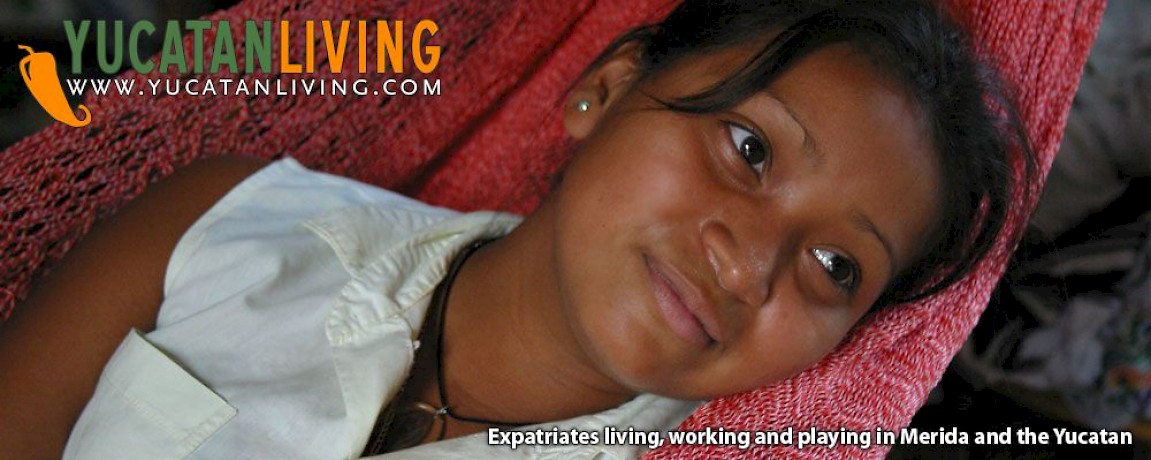


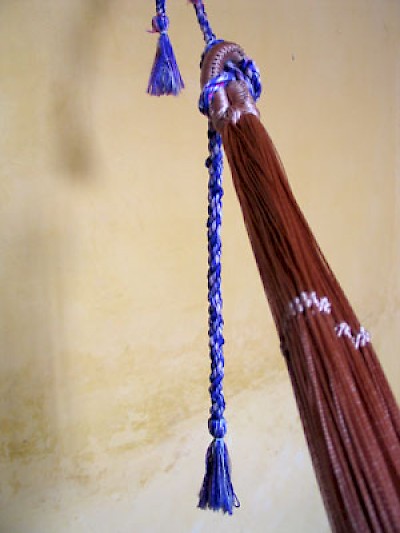
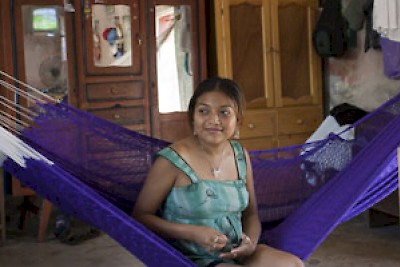

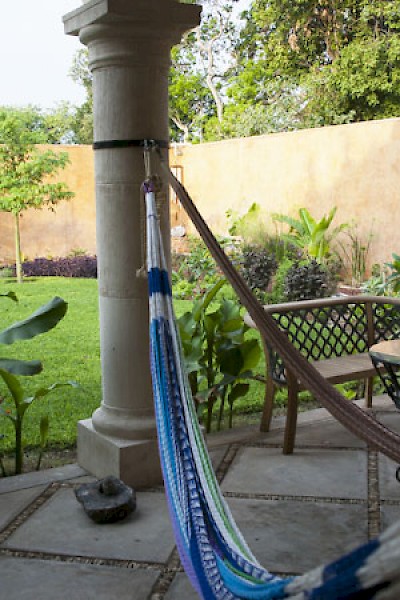
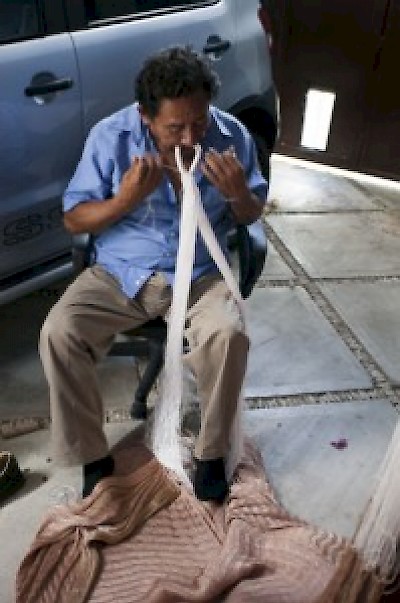
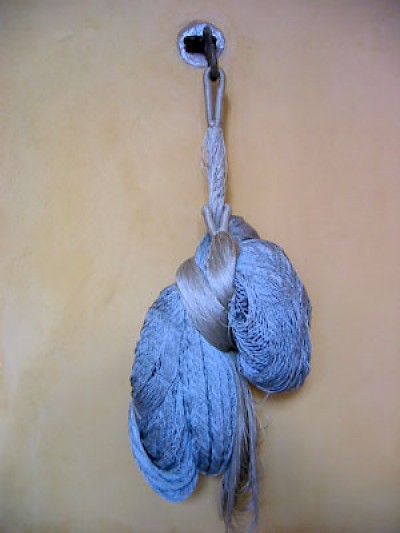

Comments
nancy 12 years ago
Ek Balam is a Mayan village full of weavers, the ruins are 100 meters from there. Great prices and beautiful hammocks.
Reply
Working Gringos 12 years ago
As we mentioned, Tixkokob is known for its hammocks. But hammocks are made almost everywhere in the Yucatan.
Reply
Working Gringos 12 years ago
Oops! An oversight! Yes, the ropes are sogas para hamaca and the hooks are called ganchos para hamacas or eses because they form a "S" shape.
Reply
HenryVG 12 years ago
Don't forget the support 'cords' that you use to attach the hamaca to the hooks and adjust the height off the floor. Almost any hardware store has them, but what are they called again?
Reply
Adri Pedersen 12 years ago
What a great article on hammocks! I have always considered hammocks an essential part of the furniture choices in Mexico. They sort of tie everything together -- no pun intended -- the allure of Mexico, the tropical climate, respect for the past and the artisanal traditions of the country ... and yes, of course the siesta and even the dream becoming reality ... when we finally decide that yes, the time is now to own a little piece of heaven in Mexico. Thanks for the article!
Reply
Sandy 12 years ago
Having a hamaca made was one of our favorite experiences, too. We bought the materials and chose blue (so the photo brought the memory back). When we went to pick up our wonderful cotton hamaca the Mayan lady and her husband who made it told us how they both looked like Smufs as they worked in it for us!
Reply
Mary Jungquist 12 years ago
Isn't there a town in the Yucatan that specializes in hammocks?
Reply
« Back (10 to 17 comments)